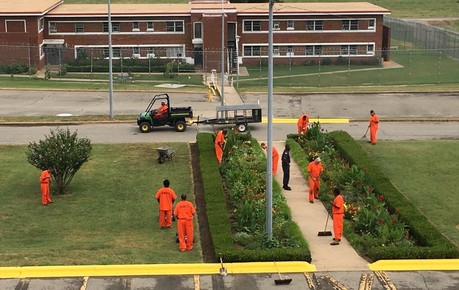OKLAHOMA CITY – The Oklahoma Department of Corrections has undertaken a number of efforts to improve security at a facility that has had four inmates walk away from it since January.
Completed Thursday, ODOC has moved all Jess Dunn Correctional Center’s 1,122 male inmates to bright orange instead of gray uniforms, part of a move system-wide to phase out the less visible, darker clothing.
The orange is immediately visible, and uniforms have the word “INMATE” brightly emblazoned on their backs (as did the gray uniforms).
Other steps the agency has taken at the minimum-security prison for men include the following:
1. JDCC has a siren that sounds when an inmate walks away from the facility. The prison has added another one that will make the alert louder and more audible to Taft residents.
This came about after the facility’s warden, Jim Farris, and ODOC’s Region I Director, Millicent Newton-Embry, spoke with area residents who complained they couldn’t hear the siren.
When JDCC has a walkaway, the nearby female minimum-security prison, Eddie Warrior Correctional Center, sounds its siren, as well.
2. ODOC continues to beef up facility security in its fenced areas of JDCC, while also improving the visual security of its perimeter.
The public should note, however, that minimum-security is very different from medium-security, and each has its roles.
For example, medium security prisons contain some of our state’s most violent and dangerous inmates – individuals who have assaulted other inmates, hurt staff, or are serving time for violent crimes.
Those prisons have double rows of tall fencing topped with razor wire (Dick Conner Correctional Center in Hominy features an electrified fence). They also have sensors on their perimeters that can detect when someone is attempting to climb over the fence or touch it.
Minimum security inmates earn more visitation and freedom of movement. This can be a motivation for inmates to improve their behavior within the facility and participate in programming that prepares them for reentry.
3. JDCC and EWCC wardens conducted a citizens’ advisory meeting recently and discussed ODOC policy on inmates assigned to JDCC and answered questions about the walkaways.
Those topics include the importance of minimum-security facilities in transitioning inmates to life on the outside.
Inmates nearing the end of their sentences are eligible for minimum-security. While in such facilities, they may participate in public works projects, such as picking up trash or grounds keeping for public areas and buildings.
4. Warden Farris has added Taft residents as requested to the resident notification list. These residents receive a phone call in the event of a walkaway, with priority being residents in the facility’s immediate area.
JDCC staff continue their close cooperation, as every facility does, with area law enforcement beyond simply coordinating responses to walkaways.
Challenges at the facility include overcrowding, an aging facility (which was not originally built to be a prison) and a persistent staffing shortage, with 31 correctional officer positions vacant this month.
###
Media Contact:
Jessica Brown, Communications Director
jessica.brown@doc.ok.gov
Office: (405) 425-7055
Cell: (405) 659-9052
Matt Elliott, Public Information Manager
matthew.elliott@doc.ok.gov
Office: (405) 425-2520
Cell: (405) 435-9173
 Jess Dunn Correctional Center inmates at work in their new, high visibility orange uniforms
Jess Dunn Correctional Center inmates at work in their new, high visibility orange uniforms
 Inmates at Jess Dunn Correctional Center in the facility cafeteria in their new uniforms
Inmates at Jess Dunn Correctional Center in the facility cafeteria in their new uniforms


